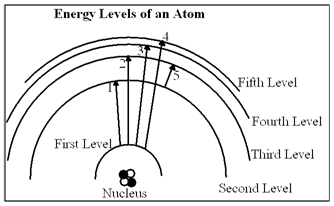In radioactive decay, when the parent material decays to one-half of its original amount, the time is
A) one half-life.
B) two half-lives.
C) three half-lives.
D) four half-lives.
Answer: A
You might also like to view...
In the diagram, which of the transitions would absorb a photon with the smallest energy (longest wavelength)?

a. Transition 1
b. Transition 2
c. Transition 3
d. Transition 4
e. Transition 5
Which of the following is a contribution to astronomy made by Galileo?
A) The astronomical telescope can show us far more detail than the eye can. B) Jupiter has four moons orbiting it. C) The Moon has craters, mountain, valleys, and dark flat areas on its surface. D) Venus appears almost fully lit when it lies on the far side of the Sun. E) all of the above
In the two-dimensional elastic collision of a particle with a stationary particle that has the same mass, the trajectories of the two particles after the collision are at right angles to each other. Explain why this should be so
What will be an ideal response?
A piano wire has a radius of 0.500 mm. One end is fixed and the other is wrapped around a tuning peg that has a diameter of 3.00 mm and is 70.0 cm away. After the wire just becomes taut, the peg is given one and a half turns
What is the fundamental frequency of oscillation of the wire? The density of steel is 7860 kg/m3 and Young's modulus for steel is 20 × 1010 N/m2. A) 1020 Hz B) 512 Hz C) 2050 Hz D) 342 Hz E) 256 Hz